How the Largest Buildings Are Changing the Skylines of Major Cities
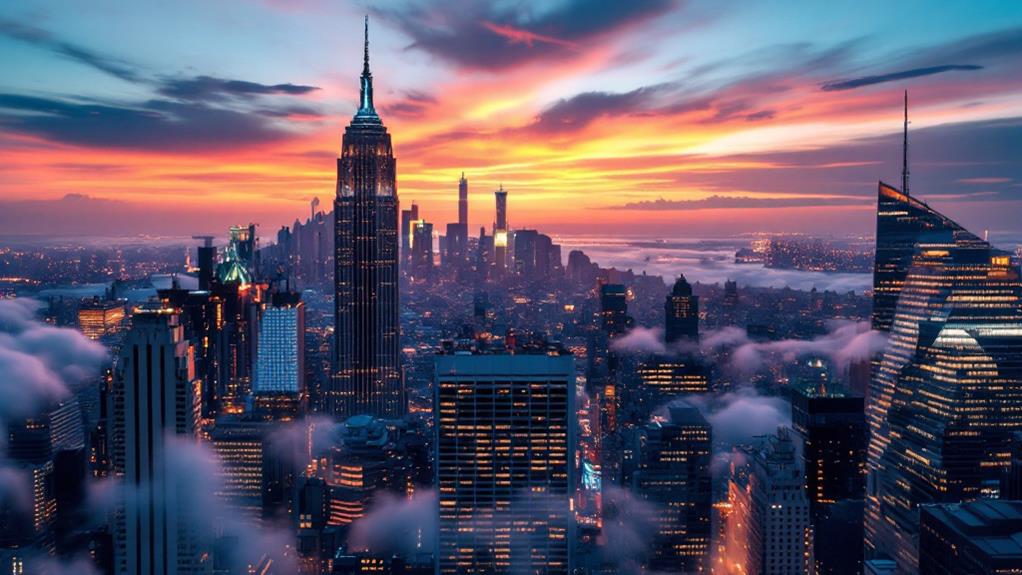
You'll see that the world's largest buildings are transforming city skylines into symbols of ambition and growth. Iconic skyscrapers like Dubai's Burj Khalifa and New York's One World Trade Center redefine urban identities. They stimulate local economies, improve cultural narratives, and introduce groundbreaking architectural designs. As cities adopt high-rises, they're prioritizing sustainable practices, mixing tradition with modernity. The dynamic blend of technology and nature creates lively vertical neighborhoods. These shifts mark a dazzling evolution, with every new tower weaving a compelling story of architectural prowess and urban progress. Uncover how these rising giants reshape entire cities' landscapes.
Evolution of Iconic Skylines
The changing silhouette of city skylines tells a story of architectural ambition and urban growth. When you look at iconic skylines like New York and Chicago, you see the evolution from low-rise structures to awe-inspiring skyscrapers. These cities have historically led the way with architectural innovation, showcasing landmarks such as the Willis Tower and One World Trade Center. The introduction of skyscrapers, beginning with Chicago's Home Insurance Building in 1885, was a game-changer in urban architecture. It allowed cities to grow vertically, making room for increasing populations.
As you investigate the skyline of Shanghai, you'll notice its rapid metamorphosis since the 1990s. The Shanghai Tower, standing at a staggering 2,073 feet, is a perfect example of modern design married with cultural significance, marking China's economic ascent. Sydney's skyline also reflects a remarkable change from a historical port landscape to a modern urban center. Buildings like Crown Sydney and Salesforce Tower symbolize this shift.
Then there's Dubai, where the Burj Khalifa redefines what you expect from city skylines. As the tallest building in the world at 2,716 feet, it sets a new standard for architectural ambition and urban innovation globally.
Transformative Power of Skyscrapers
Skyscrapers aren't just architectural feats; they transform urban landscapes and redefine city identities. When you look at the tallest skyscrapers, like the Burj Khalifa in Dubai, you're witnessing more than just a building in the world; you're seeing a symbol of ambition that has forever changed city skylines. These towering structures create iconic silhouettes that become synonymous with the cities themselves, drawing you in with their sheer grandeur.
Consider the rapid urbanization in places like Shanghai. The Pudong district, with giants like the Shanghai Tower, showcases how skyscrapers reshape not just the skyline but also the economic heart of a city. They attract global businesses and tourism, turning cities into vibrant hubs of activity. In New York City, skyscrapers have evolved from the historic Empire State Building to the modern One World Trade Center, reflecting resilience and modernization.
Here's how skyscrapers change urban life:
- Space Efficiency: High-rise buildings enhance limited urban space, offering residential and commercial opportunities.
- Cultural Identity: They symbolize a city's unique character and aspirations.
- Economic Impact: Skyscrapers elevate local economies by attracting international attention and investment.
Skyscrapers aren't just buildings; they're transformative forces reshaping the world.
Architectural Innovation in Cities
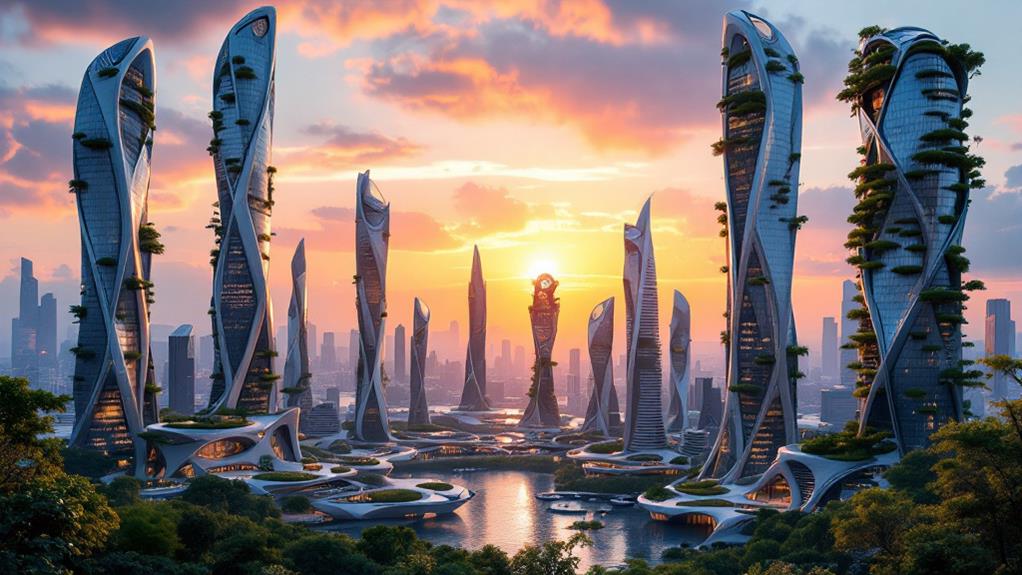
Imagine stepping into a city where every towering structure speaks volumes of human ingenuity and ambition. Architectural innovation has transformed skyscrapers into symbols of progress and modernity, reshaping urban living across the globe. The use of steel frames and advanced sprinkler systems in the late 19th century set the stage for taller, safer buildings, altering urban landscapes. Skyscrapers like the Burj Khalifa, completed in 2010, stand as monuments to engineering prowess, influencing designs worldwide.
In today's cities, skyscrapers are more than just tall buildings; they're vertical ecosystems. Take the Central Park Tower, the world's tallest residential building, completed in 2019. It showcases cutting-edge construction techniques and epitomizes luxury urban living. Meanwhile, projects like 270 Park Avenue illustrate the shift towards sustainability, integrating smart building technologies and eco-friendly materials to achieve net-zero emissions.
Furthermore, mixed-use developments, such as 175 Park Avenue, redefine what skyscrapers can offer by blending residential, commercial, and public spaces. This approach creates lively vertical neighborhoods that improve urban living. As cities continue to evolve, architectural innovation will certainly play a crucial role in shaping the skylines we admire and the communities we inhabit.
Economic Impacts of Tall Structures
In recent years, towering structures have reshaped not just city skylines but also their economic landscapes. Skyscrapers like the Burj Khalifa in Dubai transform cities into global business hubs, attracting tourism and investment that inject life into local economies. Iconic towers elevate a city's brand value, as evidenced by New York City's One World Trade Center, which contributes about $1.2 billion annually through tourism and related services.
These striking structures also enhance property values, creating thriving real estate markets. The CN Tower in Toronto, for instance, has positively influenced nearby real estate prices, augmenting the urban market's dynamism. This rise in property values often leads to increased economic opportunities, drawing businesses and residents enthusiastic to capitalize on the lively environment.
Moreover, high-rises generate jobs, particularly during construction phases. Buildings over 100 stories can create up to 4,000 jobs, impacting local employment considerably. In areas like Shanghai's Pudong district, the presence of such architectural landmarks has driven GDP growth rates to exceed 10% annually.
- Towers attract global business and tourism, enhancing local economies.
- Property values soar around iconic high-rises, augmenting urban markets.
- Skyscrapers create substantial economic opportunities and jobs.
Cultural Significance of High-Rises
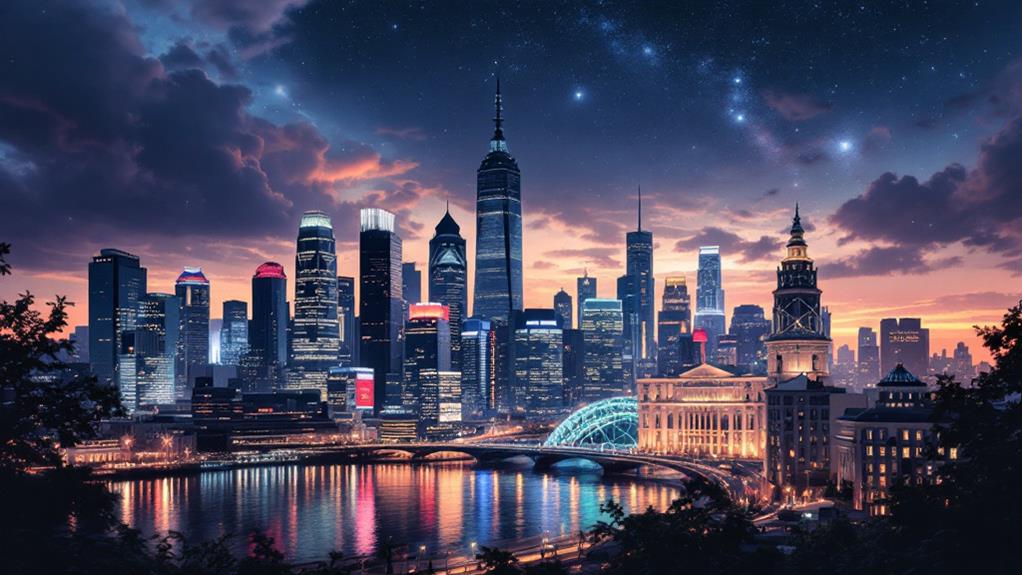
Towering above cityscapes, high-rises aren't just feats of engineering; they're symbols of cultural identity and ambition. When you look at the One World Trade Center in New York, standing proudly at 1,776 feet, you're reminded of American resilience and the nation's spirit of independence. This iconic structure isn't merely a place of business; it represents the heart of a city known for trade and cultural influence.
In Dubai, the Burj Khalifa, the world's tallest building, redefines what it means to be a global center. At 2,716 feet, it attracts millions, transforming Dubai into a hub for tourism and international business. You can't ignore its role in shaping the city's cultural identity, blending modern ambitions with traditional roots.
Meanwhile, cities like London showcase a fascinating mix of the old and new. The skyline, featuring landmarks like the London Eye and contemporary high-rises, reflects a cultural evolution that emphasizes innovation while respecting tradition.
Similarly, in Shanghai, skyscrapers like the Shanghai Tower, reaching 2,073 feet, highlight rapid economic growth. They embody international architectural styles, marking the city's modernization progression. These towering figures aren't just buildings; they're cultural landmarks that define urban landscapes worldwide.
Sustainable Building Practices
Skyscrapers are reaching new heights, not just in their size but in their approach to sustainability. By adopting sustainable building practices, these towering giants are transforming urban landscapes into eco-friendlier environments. You'll find projects like 270 Park Avenue pioneering net-zero emissions. They focus on energy efficiency, recycling an impressive 97% of demolition materials. Such initiatives showcase a commitment to reducing the environmental impact of urban construction.
Incorporating green spaces is another key trend. These cutting-edge designs include sky gardens and vertical parks, which improve urban biodiversity and elevate air quality. Imagine walking through a city and seeing lush greenery climbing the sides of skyscrapers. It's not just aesthetically pleasing but also beneficial for the environment.
Advanced materials like carbon fiber and steel are becoming the norm, reducing the total weight of buildings while maintaining strength. Additionally, many skyscrapers now integrate smart building technology to optimize energy consumption through real-time monitoring.
- Net-zero emissions: Aim for buildings with minimal environmental footprints.
- Green spaces: Vertical gardens improve biodiversity and air quality.
- Renewable energy sources: Implement solar panels and wind turbines for sustainable power.
These practices are reshaping skylines with a greener future in mind.
Future Trends in Urban Design
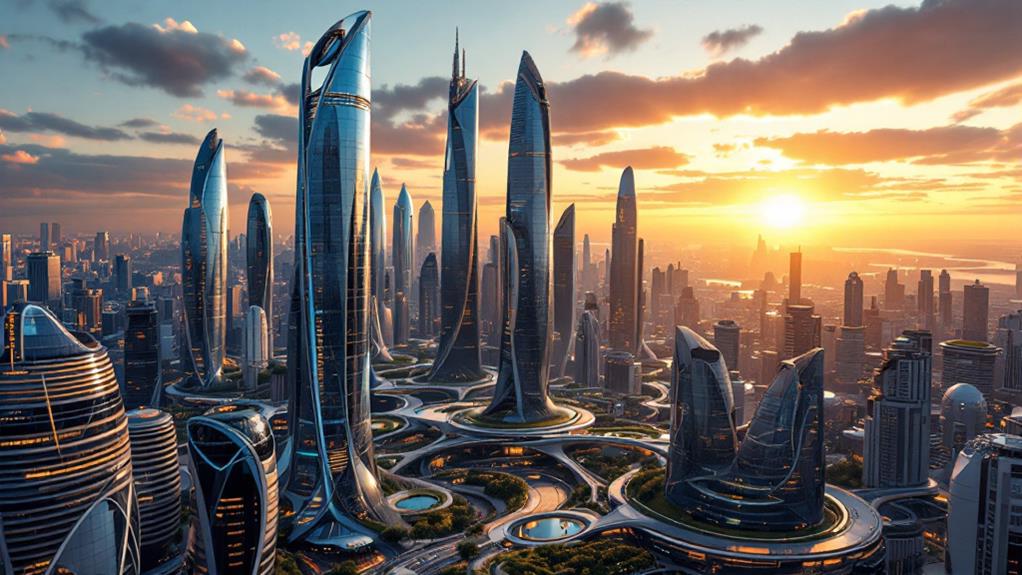
Imagine a future where cities are more than just places to live; they're lively ecosystems that seamlessly blend technology and nature. This vision is becoming reality as urban planning trends pivot towards integrating intelligent building technology in high-rise designs. Future skyscrapers won't just scrape the sky; they'll redefine it with innovations like energy-generating facades and cutting-edge materials such as carbon fiber and steel. These advancements promise not only stunning aesthetics but also improved energy efficiency and sustainability.
Mixed-use skyscrapers are at the forefront of this transformation. These towering structures, like the upcoming 175 Park Avenue, are designed to house offices, hotels, and communal spaces under one roof. By consolidating residential, commercial, and public areas, cities can foster community interaction and curb urban sprawl. This vertical neighborhood concept isn't just practical—it's vital as urban populations surge.
Safety in these future buildings will also take a leap forward. With improved resistance to natural disasters and the incorporation of IoT technologies, you'll see smarter monitoring and energy management systems. As these trends unfold, cities will evolve into dynamic environments that prioritize both innovation and sustainability.
Balancing Heritage and Modernity
The integration of modern skyscrapers into historic skylines presents a fascinating challenge. In New York City, the One World Trade Center rises alongside the iconic Chrysler Building, illustrating the delicate balance of honoring historical significance while embracing modern architectural innovation. You might wonder how cities manage to achieve this equilibrium. It's all about respecting the past while building for the future.
Consider these points when exploring this balance:
- Contrast and Harmony: The Shard in London and the Sydney Opera House with Crown Sydney demonstrate how contrasting styles can coexist beautifully.
- Cultural Roots: Shanghai's Pudong district is an example of modern skyscrapers respecting traditional architecture, blending futuristic designs with cultural history.
- Preservation Efforts: Paris shows us that it's possible to preserve historical sites even amid rapid urban development.
When you walk through these cities, you're witnessing a dialogue between periods. It's not just about erecting new buildings; it's about making sure they add value and narrative to the existing skyline. These architectural choices reflect a city's respect for its roots while embracing progress, ensuring that the skyline tells a story of both heritage and innovation.
Skyscrapers and City Identity
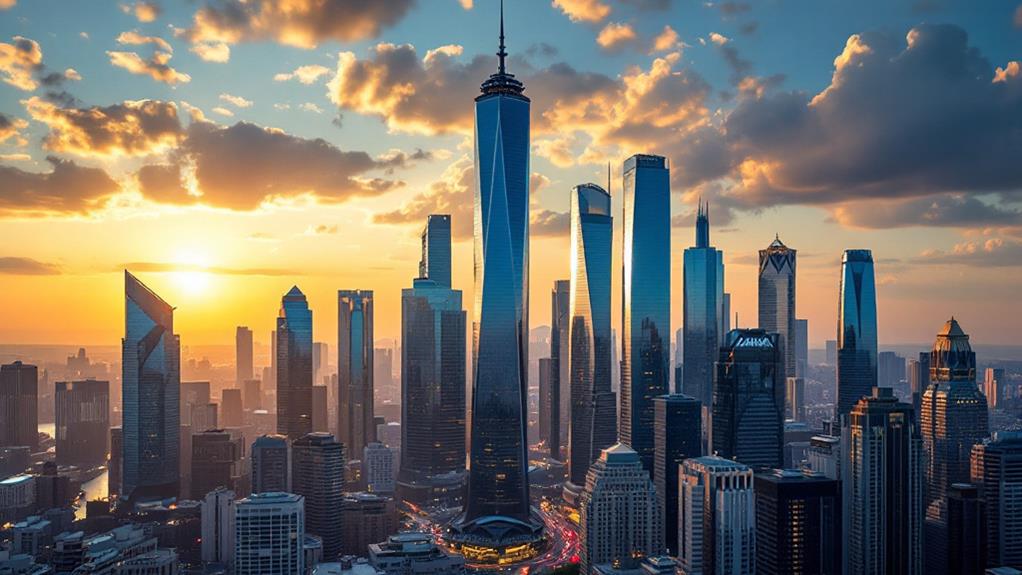
While cities evolve and expand, skyscrapers have become crucial in shaping their unique identities. In New York City, the One World Trade Center stands as a powerful emblem of resilience. Rising to 1,776 feet, it redefines the city's skyline, underscoring its status as a global financial center. Its presence symbolizes both remembrance and the city's unyielding spirit, reaffirming its identity on the world stage.
Across the globe, the Burj Khalifa in Dubai, soaring at 2,716 feet, epitomizes the city's meteoric rise from a modest port to a thriving business hub. This architectural marvel doesn't just dominate the skyline; it broadcasts Dubai's ambition and economic prowess, solidifying its place in the global narrative.
Similarly, Shanghai's skyline, highlighted by the Shanghai Tower, showcases the city's economic dynamism and cutting-edge architecture. The futuristic design reflects Shanghai's aspirations and rapid growth, reinforcing its standing as a modern metropolis.
In Sydney, the incorporation of Crown Sydney complements iconic landmarks, enhancing the city's cultural identity. Meanwhile, Toronto's CN Tower, once the tallest freestanding structure, remains a symbol of blending historical significance with modern development, shaping the city's evolving identity.
Challenges of Vertical Expansion
As cities reach for the skies with iconic skyscrapers, they encounter a set of challenges that accompany vertical expansion. Safety concerns have become more pronounced, especially after incidents like the Grenfell Tower fire, which underscore the need for stringent fire safety regulations and improved building materials. Urban planning also faces hurdles, as the towering presence of these giants can block views of cherished historical landmarks, sparking community backlash. Additionally, the structural stability of such tall buildings demands state-of-the-art engineering and groundbreaking design strategies to withstand natural forces like wind.
Moreover, high-rise developments don't always align with sustainable urban living. They can lead to increased energy consumption, putting a strain on local infrastructure if not planned properly. Residents often endure noise, traffic congestion, and temporary service outages during construction, which can greatly impact their quality of life.
Here's a quick rundown of the challenges:
- Safety Concerns: Improved fire regulations and materials are essential.
- Urban Planning: Balancing skyscraper construction with historical preservation.
- Energy Consumption: Ensuring developments contribute to sustainable urban environments.
Addressing these challenges requires a careful blend of technology, community involvement, and forward-thinking policies.



